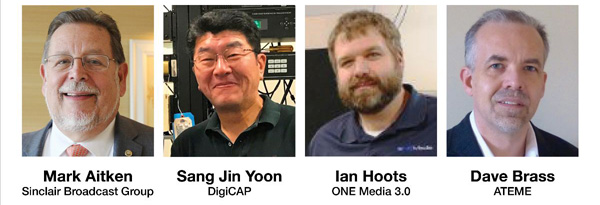
Before the Covid pandemic, when a new TV station transmission chain came online it was common for engineering management from the corporate office and key suppliers to travel to the launch site to ensure that all went well. Under the current travel restrictions, the series of Sinclair Broadcast ATSC 3.0 station rollouts needs to be managed remotely. The efficiencies resulting from this new approach could make it the way of the future.
When Sinclair’s first commercial ATSC 3.0 station went on air in Las Vegas, the team at their ONE Media controlled the launch from Sinclair headquarters in Hunt Valley, Maryland. Simultaneously, key suppliers were on call from distant locations. From South Korea, DigiCAP engineers who supplied the ATSC 3.0 air chain were monitoring the system, as well as staff members located in France and the US representing the encoder supplier ATEME.
Care and Planning
Ian Hoots, Director of NextGen Development at ONE Media 3.0/Sinclair commented, “Launching remotely requires a different level of care and planning. You have to check pre-configurations three times before you ship them to the build site because it is the last time you can conveniently touch them. This contrasts with the way these systems were built in the past, where you put all the equipment in a truck heading for the station with the basic plan of making it all work when you got there.”
SVP of Advanced Technology at Sinclair Broadcast Mark Aitken said, “What you cannot ignore is that the remote approach requires a more precise level of planning. You have a lot more latitude when the physical equipent is there. With IT systems, there is always a recipe that is very precise – exact timing, measurement and specific ingredients are needed to achieve the result.”
Dave Brass, VP Strategic Account at ATEME said other industries, such as Telecom, have already been doing remote installations for many years. Today, the remote activities have grown to include much more than just the installation. Dave said, “It can start with a digital marketing campaign for a new product, which leads to an online remote demonstration, which leads to a sale, and then leads to a remote installation. Customers sometimes ask us the minimum number of people they will need to send for an installation. Depending on what they are setting up, it can be either zero or one person.”

According to Sang Jin Yoon SVP of Business Development at DigiCAP, it is also common for the remote relationship to extend after the sale as well. Because ATSC 3.0 is the world’s first TV standard built to evolve, it could create maintenance activity from a steady stream of patches and upgrades. According to Sang Jin Yoon, his company, as well as many others, operate a managed service to automatically handle the upgrades from afar.
Predictive Maintenance
Another managed remote service is predictive maintenance. According to Yoon, this is a combination of vigilant monitoring and data science. “We monitor the behaviour of the systems and record and catalogue all events. When we analyse the records, patterns emerge. Over time, we can predict when problems will come up.”
The idea that remote operations will degrade personal relationships between TV facilities and their suppliers is another different kind of concern. But, based on his experience with the Sinclair station roll outs, Ian Hoots does not think so, “Even though we did not meet our suppliers in person, we found ourselves working quite closely with them through remote work sessions. You do miss sharing the moment when it all comes together and there is happiness in the room. Even though we miss that, we still all did an amazing job working closely with our vendors who often had to work at the edges of time windows, staying up very late for us many times. Through all of it we never felt we were at a disadvantage because they could not be here.”
While the loss of face-to-face communication between broadcasters and suppliers could be a loss to relationships, this could be more than offset by new touch points that remote work can add. Relationships could be strengthened through more frequent remote product demos as new features are added while remote managed services can add a whole new layer of post-sale contact.
From Specialised Hardware to IT
Looking forward, Mark sees the remote work done on the Sinclair station launches not as a one-off, but a rehearsal for things to come, “In many ways these remote set-ups are practice rounds for the future. As more and more operations are virtualised and move to the cloud, remote work will become more common.
“The bigger point is that specialised broadcast hardware does not exist anymore. The challenges are no longer about integrating specialized hardware, instead the issues are about compute power, memory and latency. Once a broadcaster completes the transition to IT infrastructure, they are dealing with virtualised functions, virtual machines and using standard IT servers and switches made by Dell, IBM, Cisco and HP.
"This infrastructure has been the backbone of the Telecom industry, which is now being fitted and deployed in a broadcast environment. In the Telecom industry, remote installations and other remote work have been common for many years.” www.digicaps.com





